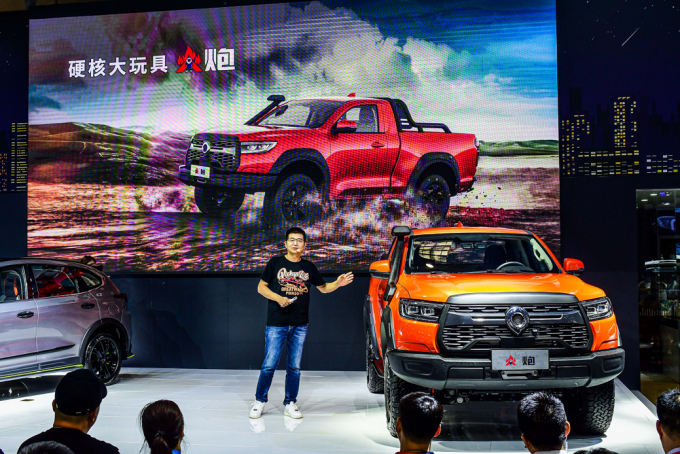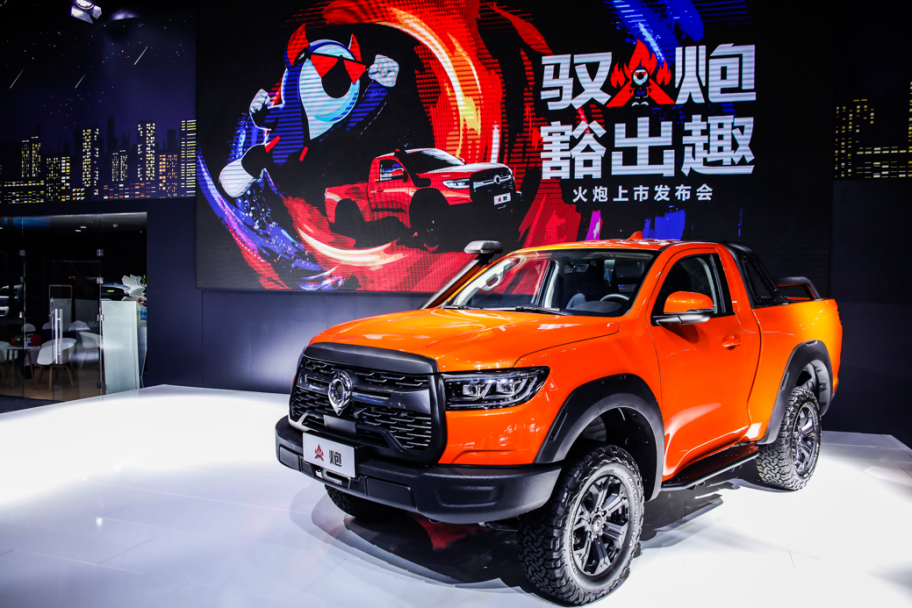*This article is reproduced from autocarweekly public number
Author: Karakush
Making money from pickup trucks seems easy, as long as you find the right way.
At the Chongqing Auto Show, the Great Wall Cannon pickup truck was officially launched with a price of 179,800 yuan, featuring a rough and masculine style, typical of its name.

This is a short-axis, single-row, double-door, two-seat off-road pickup truck, with every adjective defining its niche identity. Great Wall also understands that it is defined as a “hardcore toy” designed for “cool players, off-road enthusiasts, and competitive participants” and is the “preferred choice for super high cost-effectiveness” without seeking large quantities, but rather coming for specific scenarios and segmented markets.
If you still remember the Shanghai Auto Show in April, you will notice that this is Great Wall’s basic approach to making pickup trucks now. At that time, they officially released the “Artillery Plan”, which separated the core Great Wall Cannon pickup truck strategy into two product lines:
One is the “Cannon Series”, which includes mass-produced basic models and specially equipped models, such as the main sales model, the Great Wall Cannon passenger pickup, as well as the previously announced full-size pickup truck (claimed to be China’s first full-size pickup truck), as well as the Travel Cannon and Off-road Cannon, aiming to “create an all-scenario pickup truck lifestyle”. The Cannon Fire is also among them.

The other is the “Bullet Series”, which is the joint customization of renovation brands and renovation experts. The products that have already been unveiled include the Black Bullet co-created with Yunliang, the Dragon Bullet co-created with Yuanda Shelby, and the Fire Bullet co-created with Dinghuo. These co-brands are familiar to friends who enjoy renovating in their small circles.
To sum up, except for the earliest and most basic Great Wall Cannon model aimed at family use, the positioning of the other four Cannon models and three Bullet models can be summarized as “small but fine”-which can be said to be very clear-headed.

Today, the pickup truck market is still a highly restricted market in terms of volume, with an annual sales volume of only 500,000 units, with growth rates hovering around 9%.
What gives people hope is that in the overall car market, the pickup truck market is outperforming it, indicating that consumer demand is truly resilient. Meanwhile, policies in various regions are continuing to improve. Domestic pickup trucks have long been restricted from entering cities, but recent years have seen various relaxations, allowing pickup trucks to qualify for entry into the market.What is misleading is that loosening restrictions will lead to an explosion of demand, a boom in the market, and the emergence of a blue ocean, because restricting entry to cities is the biggest obstacle to the development of pickups – although this is partly true and partly false. “Can buy” is only a necessary condition, and reaching the top price is a return to the position that the market should have, which does not directly translate into consumer motivation to buy.
If you take a closer look at the distribution of the pickup market, the main share of pickups is still in the counties and rural areas, accounting for over 40% of the market share, with most of them purchased as production materials where there are no restrictions. The mainstream products are all competing here for the cost performance ratio.
The hoped-for increase in demand will come from urban consumers, and currently it is concentrated in small and medium-sized cities, with lower visibility in larger cities. The promotion to enter the city is loud, but the effect of entering the city is not so good. If we take 2018 when cities began to lift restrictions as the starting point, the breakthrough only happened in Beijing in 2019, which was a special case.
In that year, Beijing’s pickup sales ranked first in the country, with a licensing volume of up to 33,000 vehicles. The reason was that at that time, pickups in Beijing could be registered with blue plates without a lottery, and although pickups could not enter the Fifth Ring Road during 17 daytime hours, it was an ideal option for those without a license to enjoy free access to the suburbs of Beijing. Especially since 2018, when Beijing’s license plates have become increasingly tight, in 2019, there was also a press conference that expanded the range of pickups entering the city. It is no less perfect than a blessing from the heavenly emperor.
However, last year, Beijing announced that from this year on, cargo trucks would be banned from the nine major districts, meaning that pickups would not be able to travel within the Sixth Ring Road, so the Beijing pickup market quickly cooled and some brands directly withdrew from the Beijing market. Since then, pickup truck sales in major cities have returned to pre-ban levels overnight.
Beijing’s ups and downs are more influenced by multiple transportation policies, and thus it is a unique case.
In other major cities, such as Shanghai, restrictions on pickups were also relaxed last year, and pickups can be registered in accordance with the existing Shanghai C small passenger car management model. However, the increase in demand was very limited, with peak monthly sales of only a few hundred vehicles.
In the end, in addition to policies, there are also different demand scenarios, consumption habits, cultural atmosphere, and economic levels that influence buying decisions. Overall, Chinese cities still prefer private passenger cars and consumer upgrades. Although in the southwestern region, which is the core market for domestic pickups, there are pickup-heavy cities such as Chongqing and Chengdu – which vary in their preference but still remain relatively weighed towards pickups.Ignoring policies, it is rare for individuals to own a pickup truck in the city. This is mainly due to two mindsets: practical necessity for both transportation and commercial use, or a genuine love for pickup trucks (or a combination of the two). Even for the former, there are more modest appeals for a city pickup truck such as a more sophisticated appearance, comfortable ride, or improved aesthetics. This is where the opportunity lies.
Long gone are the days of the simple and unassuming county pickup truck. In 2019, Great Wall Motors launched the Cannon pickup truck, which solved the issue of converting a pickup truck for passenger use. Through fashionable design, the interior and experience have become luxurious and intelligent. With these upgrades, sales of the Cannon pickup truck quickly accounted for a third of Great Wall’s total pickup truck sales within six months. The Cannon pickup truck consolidated Great Wall’s position as a leading producer of pickup trucks in the market.
For years, the domestic pickup truck market maintained a 1+3+n pattern – one leader with three secondary companies and several smaller businesses, of which Great Wall Motors is the leader. With the addition of the Cannon pickup truck, Great Wall Motors sold over 220,000 pickup trucks, representing a 50% increase in sales and market share from 33% to almost 50% compared to the previous year. Until now, the market share has remained above 40%, and it has consistently been the leader in pickup truck sales in every level of city subdivisions.
It may seem like a simple strategy, but it allowed Great Wall Motors to stand out from the crowd and gain solid market feedback, indicating that there is untapped potential in the small pickup truck market. However, this requires a strong foundation within the system.
While maintaining the stability of the urban market, Great Wall Motors has also started a comprehensive search for true fans of pickup trucks. The Cannon pickup truck has set the standard.
Firstly, in terms of product differentiation, the Cannon pickup truck is highlighted not only by its single-row model but also by its off-road performance. Based on a tank platform, the pickup truck is packed with a 2.0T+8AT engine, maximum power of 160 kW, and a peak torque of 380 N・m. The OEM chassis is elevated by 2 inches, with a ground clearance of 249 mm. The approach and departure angles are 34 and 26 degrees, respectively, with a longitudinal passing angle of 28 degrees. It also has a standard towing capacity of 2.5 tons.The vehicle is equipped with the BorgWarner full-time four-wheel drive system, 8 off-road equipment including electronic differential lock for front and rear axles, nitrogen shock absorbers, BFGoodrich KO2 tires, front winch, water wading device, front and rear bumpers, side steps, and 5 reserved modification interfaces with original electrical function switches.
Compared with ordinary domestic pickup trucks, it is interesting and high-end. This has always been the case with subsequent Black Bullet and Touring Cannon. Their pre-sale prices are over 200,000 RMB, especially the high-end of the Touring Cannon is close to 300,000 RMB. Previously, WEY was not very keen on high-end segments, but now the pickup trucks are going smoothly.
The second difference is the sales method. The official “Yu Pao Er Xing” APP is its only ordering entrance, which is transparent, young, and modern.
And they have also been smart, selling only 68 vehicles per month, launching at the Chongqing Auto Show, the first batch of subsidized quotas were quickly sold out, and interested friends will have to wait until July 1st at 12:00 to participate in the second round of purchasing frenzy. With this amount, it leaves them an escape route and a flexible window for long-term development.
The third is that Great Wall is also trying to build spiritual civilization and create pickup truck culture. For example, this dedicated pickup truck APP is itself a car owner social platform, with comprehensive sections including car sharing, user Q&A, self-driving tour guides, and shopping mall. These two shirts are surprisingly well-designed and exceeding my expectations.
They also established the “Firepower Alliance” car owner club, and held user interactive activities in various places. During the Labor Day holiday, Great Wall organized more than 120 “Firepower Alliance” provincial teams from more than 20 provinces across the country, with nearly 300 people and 120 Great Wall Pao vehicles, crossing through the Mount Everest National Park from Lhasa to the base camp of Mount Everest. At the launch event of the Howitzer, this activity was completed with a certification ceremony, and they specially invited the representative of the car owners to present the certificate.
In the domestic pickup truck circle, Great Wall is beyond the norm, and deservedly ranks first.
Not long ago, they proposed a new strategic goal: by 2025, Great Wall Pickup will achieve global annual sales exceeding 500,000 units and become one of the top three pickup brands in the world.
500,000 units are not difficult, but getting into the top three is quite challenging. In last year’s global pickup sales rankings, the top three were Ford’s F-Series at 930,000, Chevrolet Silverado at 640,000, and Ram Pickup at 630,000…and this is only for one series of models, not total sales. For example, Ford’s Ranger is not counted yet, and the combined sales of Toyota Hilux and Tacoma exceed 720,000.
The gap is far away. 2025 may be too early, but as for Great Wall, why not dream of a bright future?
This article is a translation by ChatGPT of a Chinese report from 42HOW. If you have any questions about it, please email bd@42how.com.